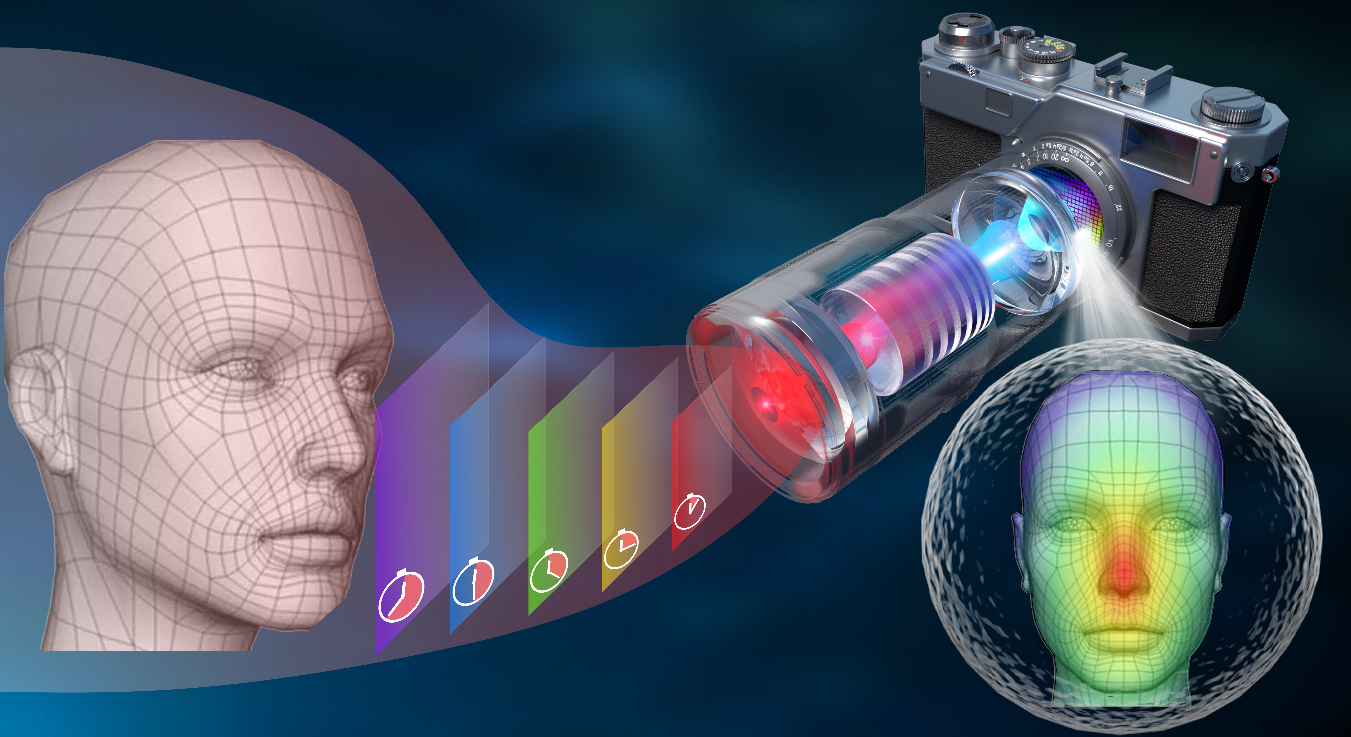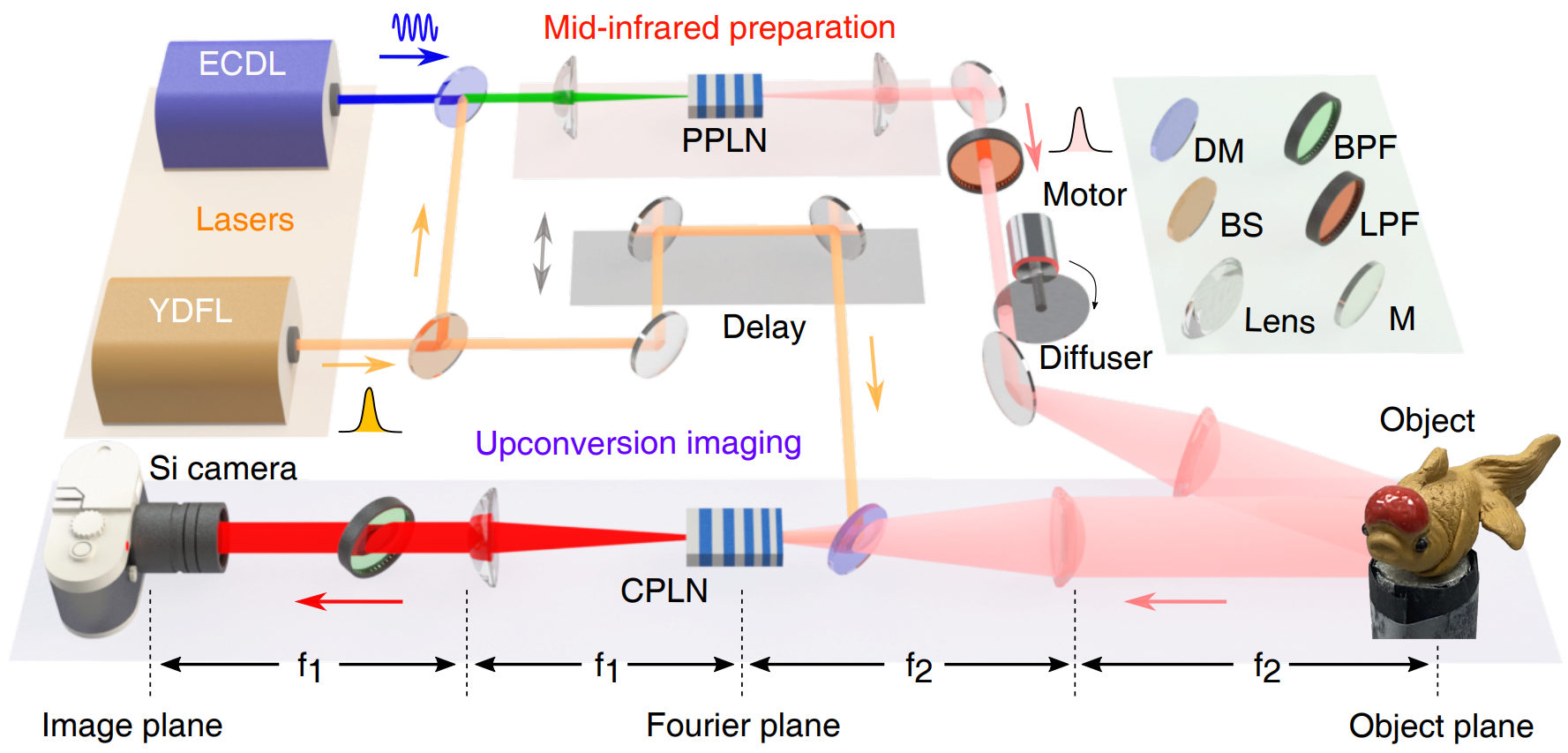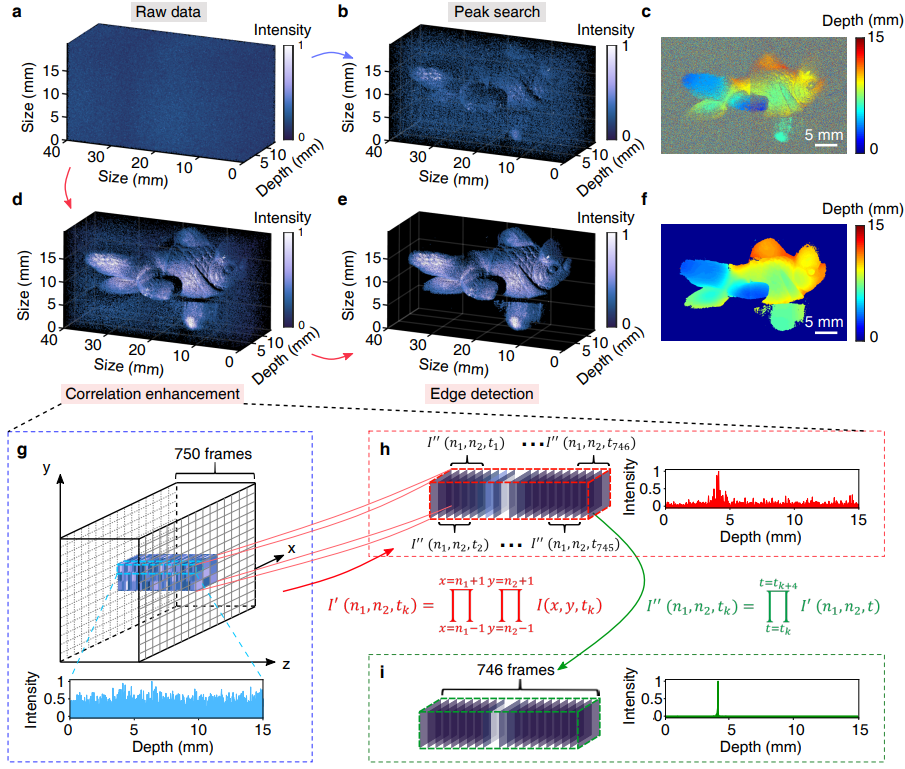The team of Professor Zeng Heping and Researcher Huang Kun from the State Key Laboratory of Precision Spectroscopy Science and Technology of East China Normal University (ECNU) has made progress in the field of mid-infrared 3D imaging, and developed wide-field-of-view, ultra-sensitive and high-resolution mid-infrared up-conversion 3D imaging technology, obtaining single-photon imaging sensitivity and femtosecond optical gating accuracy, which can provide powerful support for the non-destructive chip detection, remote infrared remote sensing and biomedical diagnosis, etc. The results were published online in Light: Science & Applications (IF=20.3) on 9 June 2023 under the title of "Mid-infrared single-photon 3D imaging". East China Normal University (ECNU) was the first author of the paper, PhD student Jianan Fang was the first author of the paper, and Prof. Heping Zeng and Kun Huang were the co-corresponding authors.

Figure 1: East China Normal University research team's research results published in Light: Science & Applications.
Laser 3D imaging technology is widely used in many fields such as autonomous driving, satellite remote sensing, and industrial production inspection because of its advantages of high imaging resolution, long measurement distance, and rich detection information. In particular, the mid-infrared band is located in the molecular fingerprint spectral region, covering a variety of functional group absorption peaks, and is capable of chemically specific identification of three-dimensional targets, which has attracted much attention in the fields of non-invasive material identification, label-free biological tissue imaging, and non-invasive medical pathological diagnosis, etc. In addition, this band contains multiple atmospheric absorption peaks, which can be used to identify the target. In addition, this band contains multiple atmospheric transmission windows, and compared with the near-infrared light has a better ability to penetrate soot and haze, which is a unique advantage in morphological mapping and remote sensing identification. For a long time, how to achieve the detection sensitivity close to the single-photon level has been an international research hotspot in the field of mid-infrared 3D imaging, which is of positive significance to promote its application in the low light flux, photon sparse micro-optical detection scenarios.

Figure 2: Conceptual diagram of mid-infrared single-photon upconversion 3D imaging.
However, single-photon laser 3D imaging has long been limited to the visible/near-infrared (NIR) band, with the main constraint being the lack of photon detection and imaging devices with high detection sensitivity and time resolution in the mid-infrared (MIR) band. In recent years, the performance of mid-infrared detectors has been greatly developed with the advancement of infrared device processes and the emergence of new materials, but still faces urgent problems such as enhancing sensitivity, improving response bandwidth, expanding pixel scale, and increasing operating temperature. Mid-infrared three-dimensional measurement can be achieved using optical coherence tomography, photothermal imaging, photoacoustic imaging and other technical solutions, but often require point-by-point scanning, unable to obtain a single high sex-to-noise ratio of the large-area array imaging. Therefore, the realisation of single-photon 3D imaging in the mid-infrared with a large field of view and high resolution is still quite challenging.

Figure 3: Diagram of the mid-infrared single-photon 3D imaging device.
To this end, the East China Normal University research team developed a mid-infrared upconversion measurement and control technique based on high-precision nonlinear optical sampling to achieve ultra-sensitive, high-resolution, large field of view mid-infrared 3D imaging, demonstrating single-photon detection sensitivity, femtosecond gating time accuracy, and megapixel wide frame. Specifically, the researchers used a nonlinear optical and frequency process to efficiently convert the signal wavelength to the visible band, using a high-performance silicon-based camera to achieve infrared imaging, thus circumventing the technical bottleneck of the existing infrared focal-plane arrays with insufficient sensitivity. At the same time, the upconversion imaging system using synchronous pulse pumping scheme, the background noise can be limited to a very narrow time window, combined with precision spectral filtering can effectively improve the detection of the signal-to-noise ratio, and thus achieve single-photon level imaging sensitivity. In addition, the researchers followed the non-linear wide-angle imaging technique previously developed by the group [Nature Commun. 13, 1077 (2022)], which can obtain large field-of-view imaging through a single exposure, eliminating the point-by-point mechanical scanning process and dramatically improving the imaging speed.

Figure 4: Mid-infrared 3D stereo imaging with a measured signal intensity of about 1 photon/pixel/second.
Further, the researchers used ultrafast optical conformal gating to accurately measure the relative time-of-flight of the mid-infrared signals, thus obtaining topographical information about the surface of the object under test. The time-resolved capability of this time-flight imaging system depends on the optical pulse width, which can achieve femtosecond-level time-tagging accuracy. Through high-speed delayed scanning and wide-field full-amplitude acquisition, the measured scene is sliced in the fast time domain, which in turn inversely performs the reflectance and transmittance of the target interface, as well as the material's absorptivity, refractivity, dispersion, and other rich information. Figure 4 shows the three-dimensional data fusion reconstruction of the target under multi-angle mid-infrared illumination, in which the measured signal intensity is about 1 photon/pixel/second.

Figure 5: Spatio-temporal correlation denoising algorithm with signal and noise levels of about 0.05 and 1000 photons/pixel/sec, respectively.
In sparse photon scenes, the effective signal is often submerged in severe background noise, and it is usually difficult to identify the measured target from the intensity information alone. For this reason, how to effectively distinguish between signal and noise light becomes a key difficulty in single-photon imaging. In order to simulate a very low illumination, high noise scene, the team attenuated the infrared signal to 0.05 photons/pixel/second, corresponding to a signal-to-noise ratio as low as 1:20,000. As shown in Figure 5a-c, the traditional intensity peak recognition algorithm is not able to effectively screen the signal. In active imaging, the signal photons received by the imaging system have a certain continuity in the time-space domain, while the background noise photons are randomly distributed throughout the time axis and spatial pixel points. Based on this characteristic, the researchers developed an accurate, efficient and robust point cloud denoising algorithm, which effectively extracts and screens signal photons by correlating the intensities of spatially neighbouring pixels and neighbouring time frames, and then realises mid-infrared single-photon 3D imaging under high background noise (Fig. 5d-i).
The developed mid-infrared three-dimensional imaging technology has the unique advantages of high sensitivity and high resolution, combined with the superior anti-scattering interference ability of this band, which is of great significance for the recovery of infrared scenes in complex environments, and can be developed into mid-infrared scattering imaging and mid-infrared non-visual field imaging. In addition, by tuning the wavelength of the mid-infrared signal, four-dimensional hyperspectral imaging can be realised, which can provide strong support for innovative applications such as material detection, non-destructive flaw detection and biological imaging.
In recent years, Prof. Heping Zeng and Kun Huang have carried out a series of innovative researches in infrared single-photon measurement and control, and have successively developed mid-infrared nonlinear wide-angle imaging [Nature Commun. 13, 1077 (2022)], mid-infrared single-photon single-pixel imaging [Nature Commun. 14, 1073 (2023)], as well as high-frame-frequency mid-infrared single-photon spectroscopy [Laser Photon Spectroscopy], and mid-infrared single-photon spectroscopy (Laser Photon Spectroscopy). single-photon spectroscopy [Laser Photonics Rev. 2300149 (2023)], among others. This work was supported by grants from the Ministry of Science and Technology, China Foundation, Shanghai Municipality, Chongqing Municipality, and East China Normal University.
Link to the paper: Mid-infrared single-photon 3D imaging
